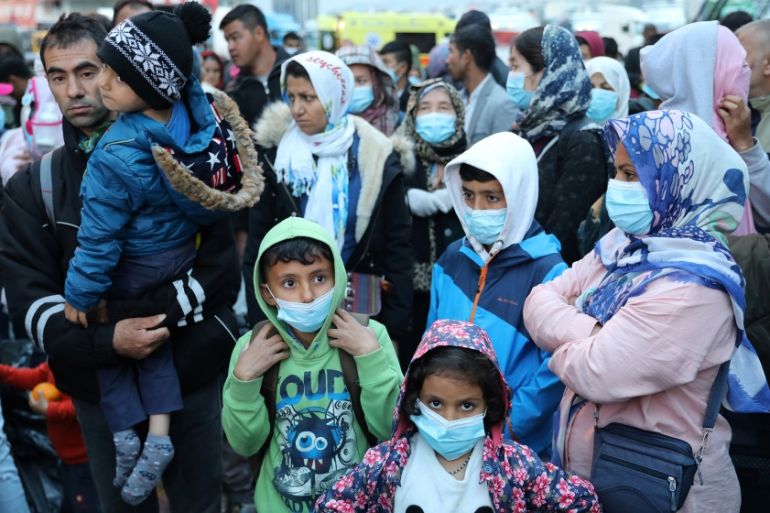What we got wrong about COVID-19 and refugees
For the world’s 26 million refugees, the health impacts of COVID-19 have not been its most lethal effects.

The coronavirus has not yet decimated refugee camps or killed displaced people in significant numbers, as I and many others feared in March. To date, only 32,000 of the world’s 26 million refugees have been registered as infected by COVID-19. While this figure is likely lower than the actual number due to weak testing capacity, even if it was tenfold higher, the spread of the virus in the US and many European nations still overshadow it.
Despite this, the pandemic is a much harder blow economically to the world’s 80 million displaced people than for those in affluent societies. Here are three things we got wrong about the coronavirus pandemic, and how they will shape humanitarian work in the year ahead.
Keep reading
list of 4 itemsRefugees must have access to COVID-19 vaccine: IOM
UN: Urgent aid needed for 3 million refugees in northern Syria
Canary Islands: Concerns grow for thousands of child refugees
COVID-19 has not ravaged refugee camps
When the pandemic began to grip the world in March, disastrous consequences were predicted for overcrowded displacement camps in places such as Bangladesh, the Democratic Republic of the Congo and Greece. Settlements in many of the 30 crisis countries where the Norwegian Refugee Council, my organisation, works are cramped and congested, and social distancing and stringent hygiene measures are often impossible.
Humanitarian activists braced for disaster, but in most places, safe programming and responsible local behaviour have prevented our worst fears from being realised so far. In the world’s largest refugee settlement in Bangladesh, only 356 Rohingya refugees had contracted the disease out of a population of more than 860,000, according to available testing by December. While testing in camps is much lower than in resource-rich western nations, we have also not seen the scale of sickness and death we feared earlier this year based on experiences in the US and elsewhere.
Several reasons point to why. First, families living in camp settings often have limited contact with local populations around them. In many countries, such as Kenya and Myanmar, refugees cannot work, so mix less with people outside. These restrictions prevent much-needed integration in local economies and livelihoods but paradoxically helped prevent the spread of the disease. Many camps also experienced stricter lockdowns than the communities outside them were bound by.
In addition, aid agencies quickly shifted programming to COVID-19 prevention when the pandemic hit. Hand-washing campaigns launched. Water and soap distribution ramped up. Social-distancing messaging rolled out, in so much as distancing was possible. In Congo, our teams distributed aid in large outdoor football fields where people could spread out. Safe programming, delivered by adaptable front-line relief workers, has no doubt saved countless lives.
Refugees have not strained local health systems
Eight out of 10 refugees across the world are being hosted by low or middle-income nations that often have weak health, water and sanitation systems. These systems were thought unlikely to be able to support high numbers of displaced people needing support when the pandemic hit. But this has not yet been an issue as the numbers of displaced people infected have remained comparatively low. Former refugees and migrants have also stepped up to support strained national health services, including in the United States where they are on the front lines administering COVID-19 tests.
In addition, about half of the 26 million refugees around the world that have been forced to flee their homes are under the age of 18. Younger people tend to be less severely affected by the disease.
The health impacts of COVID-19 have not been its most lethal effects
Research by the Norwegian Refugee Council carried out across 14 countries, including a survey of 1,400 refugees and crisis-affected people, found that a staggering 77 percent of respondents had lost their jobs or income since the start of the pandemic. The remittances from relatives elsewhere had dried up. Most families said they were less likely to send children back to school when classes restart. The economic shock to already vulnerable communities has pushed them further into destitution.
Many people living in conflict settings said they were more afraid of the hunger pandemic brought on by COVID-19 than they were of being killed by the disease itself. Our report found three out of four people surveyed had had to cut meals for themselves or their families. The UN issued similar alerts on food insecurity; in one of its starkest forecasts all year, it warned about possible famine striking four countries in 2021 – Burkina Faso, Yemen, Nigeria’s northeast and South Sudan.
Getting it right in 2021
As the new year begins, lessons must be learned from 2020. This includes a significant injection in COVID-recovery of the world’s poorest communities. The initial financial response to the pandemic was fast, but there was little or no money to meet the economic devastation that followed. The UN global COVID-19 appeal was less than half funded by year-end.
2021 will start with a record 235 million people needing humanitarian aid and protection – a 40 percent increase in just a year. And still, some donor countries have signalled they will have reduced aid budgets next year to help with their economic recoveries.
The world’s most vulnerable people must be included in global vaccine roll outs and economic recovery plans. If they do not have access to vaccines, the virus could yet grow and spread widely in refugee camps, and will never be stamped out entirely. And if displaced people are not supported financially, they will wear the economic scars of this pandemic long after the rest of us have recovered.
The international community must not punish the poorest.
The views expressed in this article are the author’s own and do not necessarily reflect Al Jazeera’s editorial stance.
